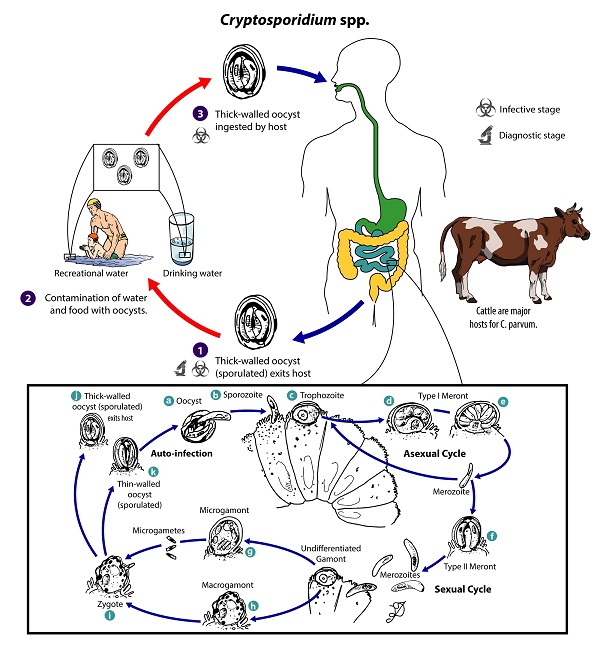Cryptosporidium parvum - Life Cycle, Pathology, Pathogenesis, Host Immunity
Life Cycle of Cryptosporidium parvum
The life cycle of Cryptosporidium parvum completes through the stages of asexual generation (schizogony) and sexual generation (gametogony) in a single host.
These parasites are truly intracellular and are surrounded by an extra-cytoplasmic host cell membrane.
Ingestion of food or drink contaminated with faeces consisting of sporulated thick-walled oocysts of Cryptosporidium parvum initiates infection in humans
in the small intestine, the sporozoites are released from oocysts
sporozoites invade enterocytes
Asexual generation (schizogony)
in asexual generation (schizogony), sporozoites differentiate into intracellular trophozoites inside the enterocytes
the trophozoites under nuclear division to multiply asexually to produce two types of meronts- type I and type II
called asexual generation or schizogony
type II meronts produce four merozoites each called type II merozoites
Sexual generation (gametogony)
in sexual generation (gametogony), type II merozoites invade new host cells and initial sexual replication i.e. sexual generation or gametogony
inside host cells, type II merozoites differentiate into macrogamont (female) or microgametocyte forms (male)
each microgametocytes produce 16 microgametes which are spermlike and fertilize the macrogamont
as a result of fertilization, oocysts are formed which in turn form four sporozoites inside each sporulating oocyst
sporulating oocysts are of two types- thin-walled or thick-walled
thin-walled sporulating oocysts release the sporozoites inside the lumen of the infection and cause auto-infection through the cycle of schizogony and gametogony
thick-walled sporulating oocysts are excreted in the faeces which ingested causes new infection
these cysts remain viable and infectious under favourable conditions for a long time
if ingested, these cysts are able to cause infection in new humans and the life cycle of Cryptosporidium parvum is repeated
*Auto-infection
It is caused by sporozoites being released from the thin-walled oocysts inside the intestinal lumen. This characteristic of Cryptosporidium parvum is responsible for the persistence of the parasitic infection.

Figure: Cryptosporidium parvum life cycle (Source: CDC)
Pathogenesis, Pathology of Cryptosporidium parvum
Cryptosporidium parvum infection affects alternations in the structure and function of the intestine such as blunting and loss of villi, lengthening of the crypts and infiltration of lamina propria by lymphocytes, polymorphonuclear cells and plasma cell
In patients with AIDS, cholera-like voluminous watery diarrhoea is seen due to a combination of secretory and malabsorptive process
infection is initiated with the attachment of Cryptosporidium parvum onto the surface of intestinal mucosa followed by an invasion of epithelial cells
after enterocytes are infected, cytokines are released
these cytokines activate phagocytes and attract new leukocytes
leukocytes release soluble factors which lead to the increased intestinal secretion of chloride, water, and inhibition of absorption
the damaged enterocytes are accompanied by osmotic diarrhoea and nutrient malabsorption
since Cryptosporidium parvum does not invade beyond the intestinal mucosal layer, they are found attached to the brush border of the mucosal surface
stained well with Giemsa and haematoxylin eosin stain
may occur in co-infection with other intestinal parasites such as Giardia intestinalis
offensive and foul-smelling stool, a characteristic of Cryptosporidium parvum diarrhoea, occurs due to bacterial fermentation of sugars and fatty acids of the unabsorbed nutrients present in the intestinal lumen
in immunocompetent hosts, Cryptosporidium parvum is restricted to the jejunum, and GI tract while in patients with AIDS, the respiratory tract is involved
Host Immunity of Cryptosporidium parvum
The host immunity against Cryptosporidium parvum also includes humoral immunity as well as cell-mediated immunity (CMI).
Humoral immunity
the number of circulating immunoglobulin IgM and IgG is increased in cases of Cryptosporidium parvum infection
although these antibodies do not provide any protective immunity against reinfection, they possibly reduce the severity of subsequent symptomatic infection
Cell-mediated immunity (CMI)
CMI along with antibody-mediated immunity helps to resolve Cryptosporidium parvum infection in an immunocompromised host